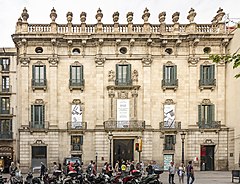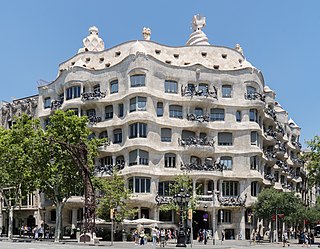
Casa Milà, popularly known as La Pedrera or "The stone quarry", a reference to its unconventional rough-hewn appearance, is a modernist building in Barcelona, Catalonia, Spain. It was the last private residence designed by architect Antoni Gaudí and was built between 1906 and 1912.

The Palau de la Música Catalana is a concert hall in Barcelona, Catalonia, Spain. Designed in the Catalan modernista style by the architect Lluís Domènech i Montaner, it was built between 1905 and 1908 for the Orfeó Català, a choral society founded in 1891 that was a leading force in the Catalan cultural movement that came to be known as the Renaixença. It was inaugurated February 9, 1908.

La Rambla is a street in central Barcelona. A tree-lined pedestrian street, it stretches for 1.2 km (0.75 mi) connecting the Plaça de Catalunya in its center with the Christopher Columbus Monument at Port Vell. La Rambla forms the boundary between the neighbourhoods of the Barri Gòtic to the east and the El Raval to the west.
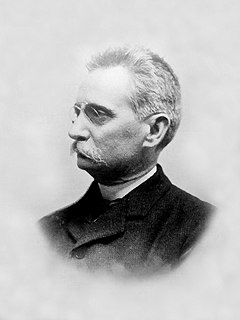
Lluís Domènech i Montaner was a Spanish architect who was highly influential on Modernisme català, the Catalan Art Nouveau/Jugendstil movement. He was also a Catalan politician.

The Museu Picasso, located in Barcelona, Catalonia, Spain, houses one of the most extensive collections of artworks by the 20th-century Spanish artist Pablo Picasso. With 4,251 works exhibited by the painter, the museum has one of the most complete permanent collections of works. The museum is housed in five adjoining medieval palaces in Barcelona's La Ribera neighborhood, in the Old City, and more specifically, it is located on Montcada Street, a formerly very prestigious street home to wealthy merchants and nobility from the Gothic to the Baroque periods. It opened to the public on 9 March 1963, becoming the first museum dedicated to Picasso's work and the only one created during the artist's lifetime. It has since been declared a museum of national interest by the Government of Catalonia.

Palau Blaugrana is an arena in Barcelona, Catalonia, Spain, belonging to FC Barcelona. The 7,585 seating capacity arena is home to the basketball, handball, roller hockey, and futsal divisions of FC Barcelona. Palau Blaugrana is located between Mini Estadi and the Camp Nou.

Vilafranca del Penedès, or simply Vilafranca, is the capital of the comarca of the Alt Penedès in Catalonia, Spain. The Spanish spelling of the name, Villafranca del Panadés, is no longer in official use since 1982. It is situated in the Penedès Depression on the left bank of the Foix River, and on the main axis of communication from Barcelona to Tarragona and Valencia, served by a Rodalies Barcelona line 4 and by the AP-7 autopista as well as by the C-243 towards Sant Sadurní d'Anoia, and C-15 roads to Vilanova i la Geltrú and Igualada respectively.

Canet de Mar is a municipality in the comarca of the Maresme in Catalonia, Spain. It is situated on the coast between Arenys de Mar and Sant Pol de Mar. el Corredor and el Montnegre ranges. It is a tourist centre, but is also known for the cultivation of flowers and strawberries and for having several modernist style buildings. It is served by the main N-II road along the coast, the highway C-32 and by a station on the RENFE railway line. Canet de Mar is in the province of Barcelona (Spain), 43 kilometers from Barcelona.
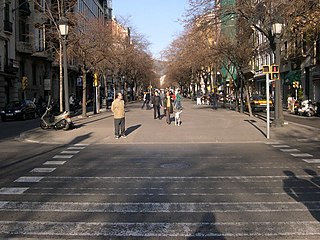
Rambla de Catalunya is a major street in the Eixample district of central Barcelona. It is one of the city's trendiest streets, with many international fashion shops, and is lined with lime trees.

Enric Sagnier i Villavecchia was a Spanish architect.

Josep Domènech i Estapà was a Catalan architect.

The Palau Reial de Pedralbes is a building placed in the middle of an ample garden in the district of Les Corts, in Barcelona. From 1919 until 1931 it was the residence for the Spanish Royal Family when they visited the city. It houses the Museu de la Ceramica, Museu Tèxtil i d'Indumentària and Museu de les Arts Decoratives, both part of the Disseny Hub Barcelona and is the permanent seat of the Union for the Mediterranean (UfM).

The Episcopal Palace of Astorga is a building by Spanish Catalan architect Antoni Gaudí. It was built between 1889 and 1913. Designed in the Catalan Modernisme style, it is one of only three buildings by Gaudí outside Catalonia.

Antoni Gaudí i Cornet was a Catalan architect known as the greatest exponent of Catalan Modernism. Gaudí's works have a highly individualized, sui generis style. Most are located in Barcelona, including his main work, the church of the Sagrada Família.
The Museu de les Arts Decoratives, in English Decorative Arts Museum, is a museum opened on 1932 and located in the Palau Reial de Pedralbes in Barcelona. Created in 1932, this historic museum contains a rich and diverse collection of European decorative arts, from the Middle Ages to the Industrial Revolution. In 1995, the museum extended its boundaries with the incorporation of design, thus converting it into the first and only statewide museum concerned with the preservation and exhibition of Spanish industrial design. The collections of the Museu de les Arts Decoratives were created from an important resource of industrial design and decorative art objects, that included salvers, carriages, furniture, wallpaper, clocks, tapestries and glasswork.
The Museu Tèxtil i d'Indumentària, in English Textile and Clothing Museum, is a museum opened on 1982 and located in the Palau Reial de Pedralbes in Barcelona. The museum possesses countless objects and pieces of major artistic and historical value that make up their collections of garments, fabrics and jewellery. Regarding their collection of clothes, the museum allows you to take a journey through the history of textiles, from the 16th century right up to the modern day. The museum's collections include Coptic, Hispano-Arab, Gothic and Renaissance fabrics, as well as embroidery, a section on lacework and a collection of prints. Also worth mentioning is the jewelry collection, comprising approximately five hundred pieces that were made and produced in Spain.
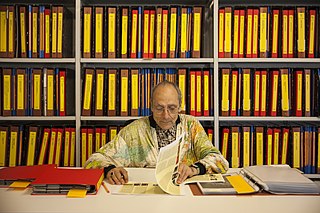
Antoni Miralda is a Spanish multidisciplinary artist.

The Casa Padellàs is a Gothic palace, originally located at number 25, Carrer Mercaders, in Barcelona. Due to the construction of the Via Laietana in the early 20th century—which otherwise would have destroyed it—the building was disassembled in 1931 and relocated to the Plaça del Rei, in Barcelona's Gothic Quarter. Since 1943, it has been home to the Barcelona City History Museum, and it is catalogued since 1962 as a Bé Cultural d’Interès Nacional with B grade, and its urban qualification is 7a(p).

The Palau del Parlament de Catalunya is the assembly hall of the Parliament of Catalonia, located in Barcelona. It was built between 1717 and 1727 as the arsenal of the Ciutadella, to designs of Jorge Próspero de Verboom.
